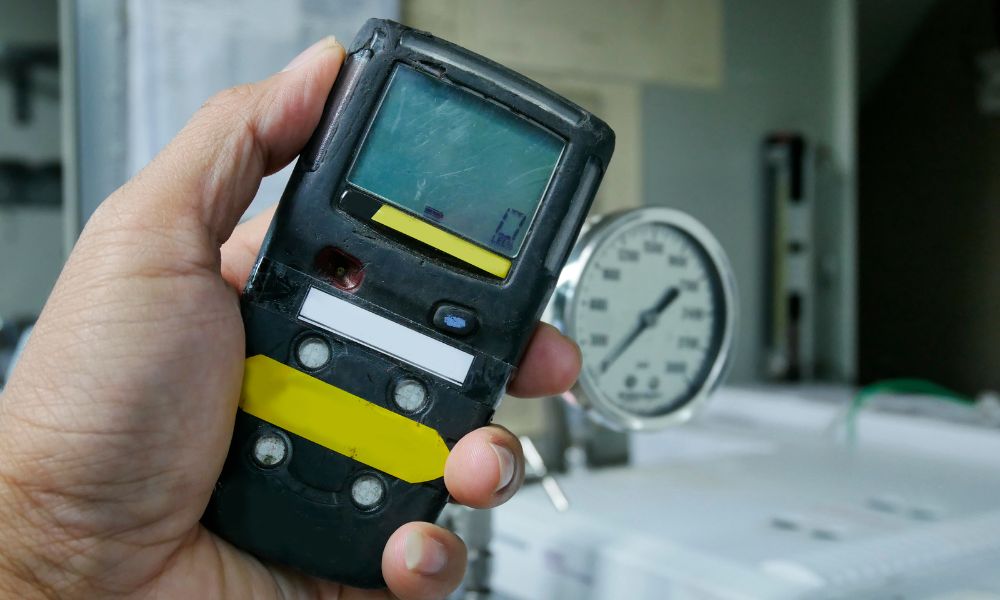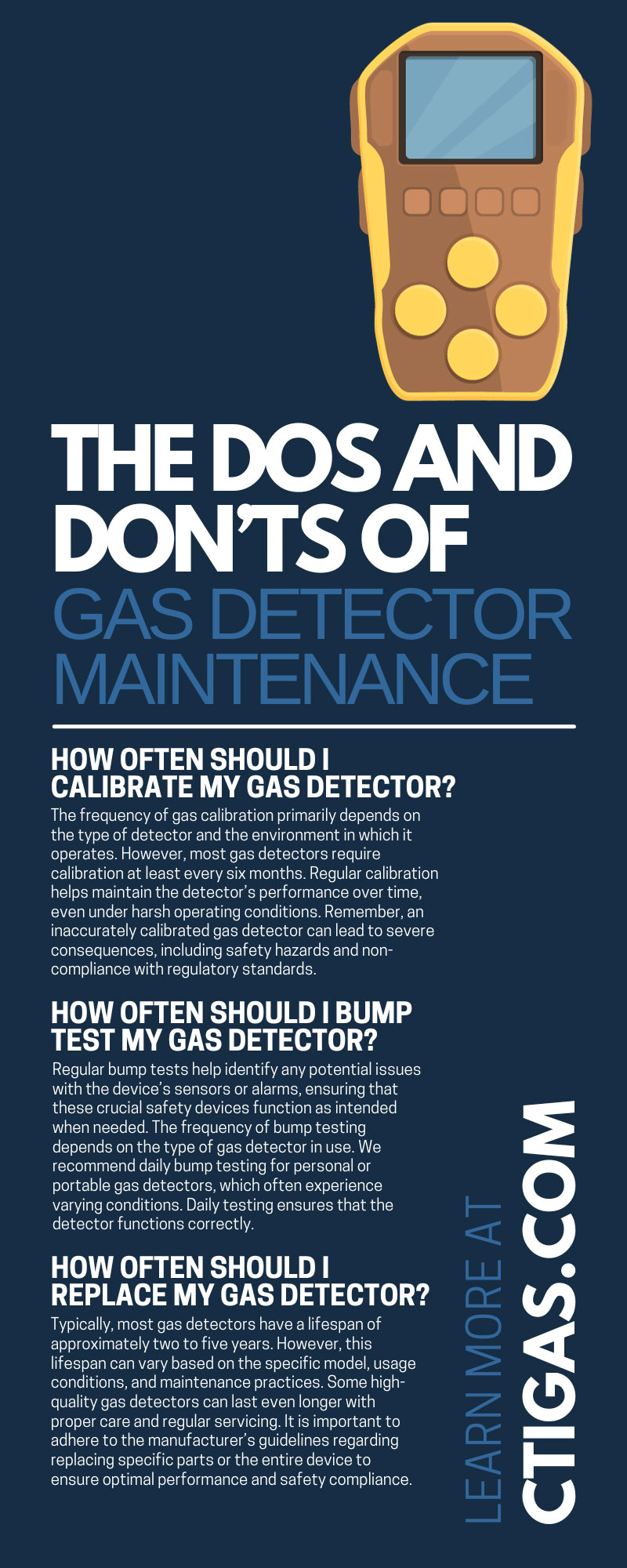
Industrial-grade gas detectors are vital for maintaining safety and operational efficiency in various facilities. These devices identify hazardous gas leaks that could potentially result in catastrophic events, including explosions, fires, and toxic exposure. By detecting these gas leaks promptly, they help protect lives, safeguard the environment, and prevent significant resource losses, thereby contributing to the overall success of a business.
However, the performance of these detectors depends heavily on their maintenance. Proper maintenance ensures that gas detectors function accurately and reliably, providing businesses with safety assurance and compliance with regulatory standards. Regular calibration, testing, and timely replacement are all integral aspects of this maintenance process. Read on to learn more about the dos and don’ts of gas detector maintenance.
How Often Should I Calibrate My Gas Detector?
Gas calibration is a crucial maintenance procedure that ensures the accuracy and reliability of your gas detector. It involves exposing the device to a known concentration of test gas, allowing it to recalibrate its sensors and provide accurate readings. The purpose of this process is to align the detector’s response to a known concentration of gas, ensuring that it can accurately measure the gas levels in your facility.
The frequency of gas calibration primarily depends on the type of detector and the environment in which it operates. However, most gas detectors require calibration at least every six months. Regular calibration helps maintain the detector’s performance over time, even under harsh operating conditions. Remember, an inaccurately calibrated gas detector can lead to severe consequences, including safety hazards and non-compliance with regulatory standards.
The Dos and Don’ts of Gas Calibration
Calibrating your gas detector is a precise procedure that requires experience and specific certifications. Do send your devices for in-house gas detector calibration services. Professionals who perform these services have the necessary experience and certifications to ensure that your device is operational. They can also provide suitable certification, confirming that your device is ready for use. Furthermore, both you and the service professionals must follow the manufacturer’s instructions for calibration. After all, each gas detector is different.
On the other hand, don’t attempt to calibrate your gas detector without the necessary knowledge or experience. Improper calibration can compromise the accuracy and reliability of your gas detector, leading to potential safety risks. Additionally, you shouldn’t ignore the need for regular calibration. Even if your gas detector seems to be working fine, regular calibration is essential to maintain its accuracy and reliability.
How Often Should I Bump Test My Gas Detector?
Bump testing is the second most common maintenance procedure associated with gas detectors. Similar to calibration, it is a simple process that involves exposing the gas detector to a known concentration of gases. However, this concentration is higher than the gas detector’s alarm threshold; a bump test exposes devices to high concentrations of gas to ensure they respond and work properly!
The importance of bump testing in proper gas detector maintenance is impossible to overstate. Regular bump tests help identify any potential issues with the device’s sensors or alarms, ensuring that these crucial safety devices function as intended when needed. The frequency of bump testing depends on the type of gas detector in use. We recommend daily bump testing d for personal or portable gas detectors, which often experience varying conditions. Daily testing ensures that the detector functions correctly. On the other hand, fixed or static gas detectors, which operate in a more controlled environment, require bump testing every three to six months.
The Dos and Don’ts of Bump Testing
When conducting a bump test, there are certain practices to adhere to and others to avoid. Wear proper Personal Protective Equipment (PPE) while testing a bump. Since you will be exposing your device to a high gas concentration, it is important to take caution and protect yourself from potential exposure. Similar to gas calibration, it’s also important to follow the manufacturer’s guidelines for bump testing. Each gas detector may have specific requirements for bump testing, and adhering to these guidelines ensures that the test is conducted effectively.
Don’t neglect regular bump testing. This procedure is the primary way to test the proper function of your device and is crucial to your safety. Furthermore, don’t ignore or downplay a failed bump test. If your gas detector fails a bump test, it indicates a potential issue with the device’s sensors or alarms. This failure could be a sign of a more significant problem that requires professional attention.
How Often Should I Replace My Gas Detector?
Modern gas detectors provide long-lasting service. Manufacturers use advanced technologies and robust materials to ensure that these devices can withstand challenging industrial environments and provide reliable performance over extended periods. However, like all electronic devices, gas detectors are not immune to wear and tear. Their internal components, particularly the sensors, can degrade over time due to continuous exposure to harsh conditions and regular use.
Typically, most gas detectors have a lifespan of approximately two to five years. However, this lifespan can vary based on the specific model, usage conditions, and maintenance practices. Some high-quality gas detectors can last even longer with proper care and regular servicing. It is important to adhere to the manufacturer’s guidelines regarding replacing specific parts or the entire device to ensure optimal performance and safety compliance.
The Dos and Don’ts of Replacing Gas Detectors
Before you decide to replace your gas detector, it’s crucial to ensure that the problem does not lie with an accessory or peripheral component. This simple step can save you significant time and money. For instance, a seemingly malfunctioning gas detector could be experiencing issues due to a depleted battery or a faulty power supply.
Do check the batteries and power supplies thoroughly. If your gas detector runs out of charge quickly or fails to power up, the problem could be with the batteries or the power supply rather than the device itself. Additionally, you must inspect any attached cables and other accessories for damage or complications. A loose or damaged cable could affect the functioning of your gas detector, giving the impression that the device itself is faulty. Ultimately, don’t rush to replace your gas detector without thoroughly checking all components. It might be a simple issue that requires a quick fix or replacement of a specific part rather than the entire unit.
With all the “dos and don’ts” surrounding proper gas detector maintenance, it’s normal to feel confused or overwhelmed! If you have any questions about calibrating, bump testing, replacing your gas detectors, or any other aspect of gas detector maintenance, we encourage you to contact our CTI team. Our experts are always ready to assist you and provide the guidance you need to ensure that your gas detectors operate at their best. Remember, a well-maintained gas detector enhances safety and contributes to the smooth operation of your facility.


